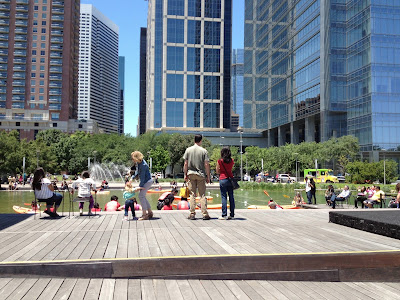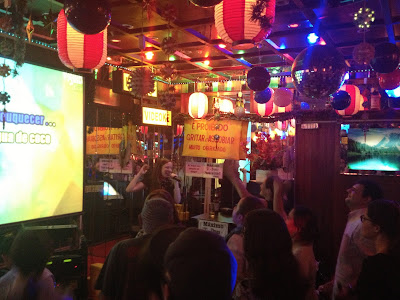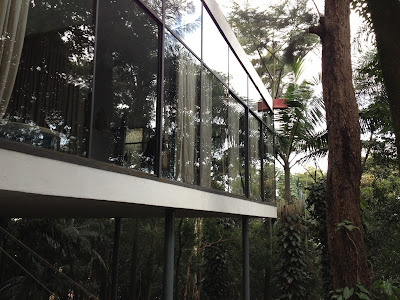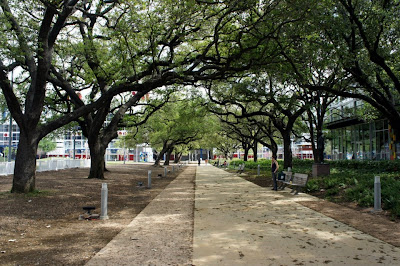I had the opportunity this past weekend to attend two different performances at the Houston Grand Opera: Verdi's
Il trovatore and Wagner's Tristan and Isolde. Below are a few
thoughts on the two productions, which conclude the 2012-2013 HGO season.
Saturday night's performance of Il trovatore was, as expected, a stirring, high-energy feat carried
by Italian tenor Marco Berti (Manrico) and soprano Tamara Wilson (Leonora).
It's easy to understand why Il trovatore
was Verdi's most popular opera during his lifetime, and why it is still widely
considered the most melodic opera ever written. The tale itself is quite dark,
culminating—spoiler alert—in a loving mother witnessing the execution of her
adopted son, which simultaneously avenges the death of her own mother. In fact, something I
have always found unusual about the work is the contrast between the
sing-along-esque melodies and the gory details of burning at the stake, baby
killing, torture, sexual anger, etc. That said, the action is so swift and
propulsive, with characters entering the stage "as if shot out of a
cannon," in the words of Eduard Hanslick, that one cannot help but be
swept up in the work's unhesitating life-affirmingness (and then feel grateful
for it).
A bowl of pork ramen (1), a few hours of sleep, brunch at
Lakeside, and an iced Turkish coffee at Phoenicia (2) later, I was back
at Wortham Theater (3) for the Sunday matinee performance of Tristan and Isolde.
- New favorite downtown late-night spot: Goro and Gun (306
Main). Craft cocktails and homemade ramen until 2 am—what's not to love? Also,
they have a stuffed lion.
- Try the new iced Turkish coffee at Phoenicia.
- 3 + 4.5 = 7.5 hours is a long time to sit at any one spot in
a 24-hour period. But the Wortham is definitely not a bad place to do it. Plus consulting is building up my Sitzfleisch
(one of my favorite German words, literally "sitting flesh").
Back to
Tristan and Isolde. It's difficult to overstate the importance of
the work in terms of Wagner's career, as well as, in fact, within the context
of the development of Western music (see
Tristan chord). The narrative itself, Wagner's reinterpretation of a Celtic myth, is a "profound
spiritual journey through the minds of the two title characters," writes HGO
artistic and music director Patrick Summers. "For
some,
Tristan and Isolde is the
greatest love story ever told. For others, it is about oblivion itself."
The co-production
with London's Convent Garden was extraordinary—as cited in the WSJ's review
"
A Liebestod to Die For," thanks to "a magnificent soprano, a
laser-focused production and an energetic conductor." Indeed, the performance
by Swedish soprano Nina Stemme (Isolde), one of those once-per-generation
talents and, for good reason, the most internationally sought-after Wagnerian soprano
today, was both stunning and provocative. (Canadian tenor Ben Heppner's
rendition of Tristan, on the other hand, though critically acclaimed, seemed a
bit strained, at least during Sunday's performance. To be fair, in addition to
originally being considered impossibly demanding for orchestra, the opera's title roles
were at first considered unsingable, and the original Tristan, Ludwig Schnorr, allegedly
died from the strain of singing the first four performances in 1865.) Another
highlight was German director Christof Loy's insightful staging, which divided
the stage into two distinct areas: a rear area that alternately served as the
ship and the royal court, and a stark front area that served as the setting for
the main characters' tortuous psychological developments. The delicate
interplay between the two areas and the moving curtains between them elevated
the dialogue between light and darkness, life and death, the "world of
day" and the "realm of night" to a new level.
What made attending
the back-to-back performances particularly special, apart from them both being excellent
productions, was being able to compare landmark works by two 19th-century
contemporaries—both composers were born in 1813, Verdi a few months after
Wagner. As the program notes explain:
The differences
between these two artistic giants and their divergent approaches to music and
theater reveal a story in which we are still characters. Obviously, the world
has indescribably changed since their lives, but we are still wrapped in the
same conversation about art's purpose and role, and even the very definition of
culture.
Patrick Summers
writes:
Il trovatore and Tristan and Isolde intriguingly
illustrate the differences between the two composers; Verdi's music seems to
well up from the earth itself: solid, stalwart, immediate, and comforting.
Wagner's is from another realm entirely, from something just beyond ourselves,
from the spheres perhaps, but certainly not of this world. It is unsteadying,
provocative, and challenging. Il
trovatore's score has a powerful and propulsive energy; Tristan and Isolde portrays time as
simply another dimension of the turmoil between the two lovers. Il trovatore's action is constant and
quicksilver…the "action" of Tristan
and Isolde occurs only in the final pages of each act, while the remainder
of the work takes place in the minds of the characters. These workings of the
mind—a set of exposed inner narratives—are revealed principally by the
orchestra.
New fact I learned
from the program notes that I would never have guessed before:
Tristan and Isolde was originally conceived as a "small scale
work that would deliver him the lucrative success of the Italian and French
operas" of his time. Pretty surprising, considering the monumental nature
of a complex work that marches on for near five hours as well as Wagner's disdain
for commercially driven—and what he considered to be artistically inferior—Italian
and French works (incidentally, the topic of
a history essay I wrote senior fall). What began as a commercial project, it turns out, had dueling inspirations:
Arthur Schopenhauer's philosophical treatise
The World as Will and Representation and an affair with
Mathilde Wesendonck, the wife of Wagner's Zurich savior and patron—evidently
when Wagner and his first wife Minna fled to Zurich from Germany in the aftermath
of the revolutionary movement in which Wagner took part, the wealthy Otto and
Mathilde Wesendonck provided the Wagners with a house adjacent to their villa, where
Richard Wagner developed an intimate artistic and personal relationship with
Mathilde.
(In case you wonder, as I have, why Wagner seems to gloss over the
forgiving King Marke's less-than-expectedly unhappy demise at the end of Tristan, consider that after sh*t hit
the fan when Minna grew jealous of Mathilde and threatened a public standal, Wagner
grew jealous of an academic who was teaching Mathilde Italian, Minna was sent
to a spa for health issues, the Wesendoncks left Zurich to travel, and Wagner
was left heartbroken and bankrupt, Otto once again intervened to settle
Wagner's debts in Zurich before providing him with funds to travel to Venice.)
At any rate, a final
word on Wagner from the program notes to end this post:
Wagner was vilified
in his lifetime, an embarrassment to most of his fellow artists, an enigma to
philosophers like Nietzsche, and thought by many of his contemporaries more
madman than visionary. In hindsight, we can see more of the brilliance of his
creations, even as his views and character account for endless debate and
always will. He is uniquely uncooperative to analyze and write about, which the
approximately 30,000 books about him can attest. His repulsive anti-Semitism
has been examined and argued, sometimes simply dismissed as typical of the
time, but that argument can't and mustn't erode the fact that Wagner used a
portion of his fame to promote a set of ideas that became murderous in the
twentieth century. Perhaps the fact that such a controversial and morally
fallible man could write works of such unutterable beauty and depth can give us
some hope for mankind.
 |
| Tristan and Isolde cast |



































